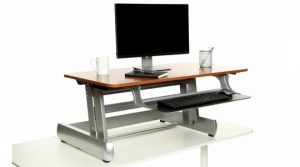Sit stand tables are becoming increasingly popular in the office environment. Greater amount of model types are entering the market, all proclaiming to have outstanding benefits; but are they actually good for us? Do sit stand tables help to relieve pain? And is sitting the new smoking? In this article, we will answer those questions.
Firstly, is sitting bad for us?
In short, long periods of uninterrupted sitting is not good for our general health. More research is starting to show that the more sedentary we are, the increased chance we have at developing chronic disease such as diabetes, cardiovascular disease, obesity and some types of cancer. On top of this, it is also detrimental to our musculoskeletal system, with increased load being put upon our muscle and joints, particularly that of the spine. After repeated exposure to long durations of sitting, this can develop into pain.
So what benefits to sit stand tables offer?
- The promotion of greater movement in the workplace, thus decreasing the risk of chronic disease and musculoskeletal pains which are exacerbated by sitting (e.g. neck and low back pain)

- The reduction of sedentary postures which may contribute to the above
- Decreased postural strain on the body and reduction of RSI risk
- Increased energy levels as increased movement promotes blood flow through the body
- Increased productivity as our energy levels are greater
- Possibility of earlier return to work for some workers who cannot sit due to injuries or surgery (e.g. back surgery)
Therefore, if we incorporate more movement into the working day, we can prevent issues related to sedentary postures from developing, hence the answer, sit stand tables are good for us. However, they must be used correctly:
- Change between sitting and standing at least every 45 minutes
- Avoid standing for greater than one hour at a time, and longer than four hours on any working day
- When adjusting the height of the desk into standing, ensure your elbows are just above the surface of the desk so that it is at the correct height
There are a range of sit stand tables available all with their own pros and cons;
- Electric tables
- Pros – easy to adjust, convenient, no strain on the body when adjusting, whole desk can move rather than selected parts, good stability in standing
- Cons – price can be expensive, are large and can be hard to it into some office spaces
- On top of desk manual tables
- Pros – better if price is an issue, quick adjustment into standing if spring/gas lift loaded, easy to move around the office
- Cons – limited as to equipment which can be placed on it, requires user to exert force to lift and lower, may not be high enough for taller employees
- Deskalator – Gas loaded, easy to adjust, two sizes for either single or dual screen, modern look, pure vertical adjustment for added stability
- DT2 – larger model and larger workspace in standing, spring loaded for easy adjustment, higher adjustment for taller employees
If you are unable to purchase a sit stand table, there are other alternatives to prevent side effects of sedentary positions occurring;
- Incorporate movement into your day – take sitting breaks every 45 minutes
- Ensure that you have the correct ergonomic set up – Have an ergonomic assessment by a professional to decrease the risk of developing pain
- Convert traditional meetings into standing or walking meetings
- Only half fill up your cup or bottle so you stand and move to the kitchen more often
- Print documents regularly rather than all at once
- Walk to colleagues for contact rather than sending e-mails
Bodysmart can help to determine the need for a sit stand table through our Ergonomic Assessment Services. To find out more, click the link below or give us a call on 9481 8708.












